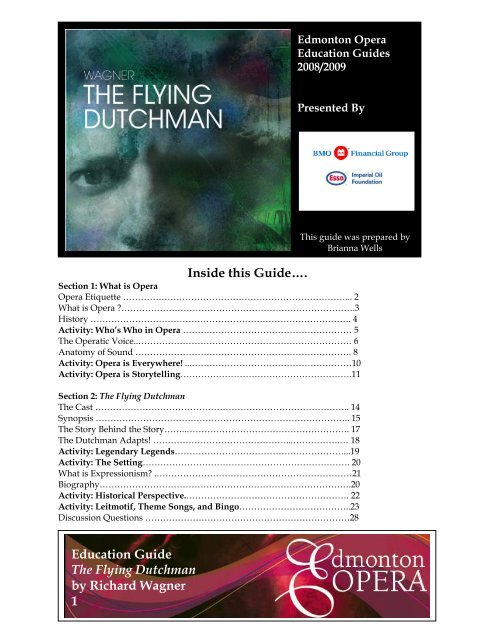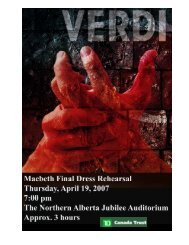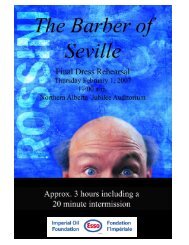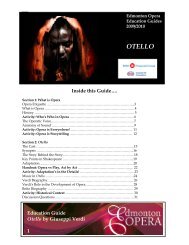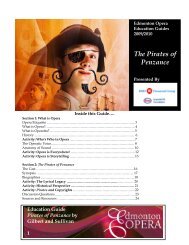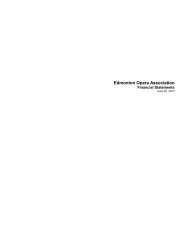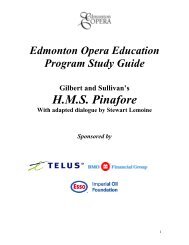Education Guide The Flying Dutchman by ... - Edmonton Opera
Education Guide The Flying Dutchman by ... - Edmonton Opera
Education Guide The Flying Dutchman by ... - Edmonton Opera
You also want an ePaper? Increase the reach of your titles
YUMPU automatically turns print PDFs into web optimized ePapers that Google loves.
<strong>Edmonton</strong> <strong>Opera</strong><br />
<strong>Education</strong> <strong>Guide</strong>s<br />
2008/2009<br />
Presented By<br />
Inside this <strong>Guide</strong>….<br />
This guide was prepared <strong>by</strong><br />
Brianna Wells<br />
Section 1: What is <strong>Opera</strong><br />
<strong>Opera</strong> Etiquette …………………………………………………………………... 2<br />
What is <strong>Opera</strong> ?…………………………………………………………………….3<br />
History ……………………………………………………………………………. 4<br />
Activity: Who’s Who in <strong>Opera</strong> ………………………………………………… 5<br />
<strong>The</strong> <strong>Opera</strong>tic Voice..……………………………………………………………… 6<br />
Anatomy of Sound ………………………………………………………………. 8<br />
Activity: <strong>Opera</strong> is Everywhere! ...………………………………………………10<br />
Activity: <strong>Opera</strong> is Storytelling………………………………………………….11<br />
Section 2: <strong>The</strong> <strong>Flying</strong> <strong>Dutchman</strong><br />
<strong>The</strong> Cast ………………………………………………………………………….. 14<br />
Synopsis ………………………………………………………………………….. 15<br />
<strong>The</strong> Story Behind the Story……..………………………………………………. 17<br />
<strong>The</strong> <strong>Dutchman</strong> Adapts! ………………………………………...…………….… 18<br />
Activity: Legendary Legends…………………………………………………...19<br />
Activity: <strong>The</strong> Setting……………………………………………………………. 20<br />
What is Expressionism? .…………………………………………………………21<br />
Biography………………………………………………………………………….20<br />
Activity: Historical Perspective.………………………………………………. 22<br />
Activity: Leitmotif, <strong>The</strong>me Songs, and Bingo………………………………..23<br />
Discussion Questions ……………………………………………………………28<br />
<strong>Education</strong> <strong>Guide</strong><br />
<strong>The</strong> <strong>Flying</strong> <strong>Dutchman</strong><br />
<strong>by</strong> Richard Wagner<br />
1
<strong>Opera</strong> Etiquette<br />
ALWAYS BE EARLY! Once a performance begins, no one will be allowed<br />
into the theatre until intermission because it will disrupt other patrons. We<br />
suggest you arrive half an hour early to pick up your tickets, and prepare to<br />
enter the auditorium fifteen minutes prior to showtime.<br />
USE THE RESTROOM. Once in the theatre it is courteous to remain seated<br />
and involved in the production until intermission. Please do not leave the<br />
theatre unless there is an emergency.<br />
PLEASE BE COURTEOUS to everyone in the audience and on stage. <strong>The</strong>atre<br />
is live performance, so any talking, cell-phone use (including texting) or other<br />
noise/light disruption takes away from everyone’s experience at the opera.<br />
APPLAUSE WELCOME! <strong>Opera</strong> is spectacle. Your presence in the audience<br />
is essential to complete the whole experience. Enjoy the performance and<br />
respond to what you see. Unlike television or film, every live performance is<br />
unique: only you and the performers will share the experience you have in the<br />
theatre. Your warmth and good humour are important to them, so when you<br />
like something, tell them with your applause.<br />
NO FOOD, DRINKS, OR GUM IN THE THEATRE. This rule is strictly<br />
enforced.<br />
NO CAMERAS OR TAPE RECORDERS: the artists’ images and<br />
performances belong to them and we ask you to respect that <strong>by</strong> refraining<br />
from recording their work in any way.<br />
<strong>Education</strong> <strong>Guide</strong><br />
<strong>The</strong> <strong>Flying</strong> <strong>Dutchman</strong><br />
<strong>by</strong> Richard Wagner<br />
2
What is <strong>Opera</strong>?<br />
<strong>The</strong> word opera is the plural form of the Latin word opus (which translates quite<br />
literally as work). Today we use the word opera to refer to a theatrically based musical art form<br />
in which the drama is sung (without microphones!), rather than spoken, and is accompanied <strong>by</strong><br />
a full symphony orchestra.<br />
<strong>Opera</strong> was born out of the belief that drama can be better expressed <strong>by</strong> music and text than <strong>by</strong><br />
text alone. One of the unique things about opera is how it combines so many different art forms<br />
(music, drama, and visual arts) to create an artistic spectacle. Of course, the use of many art<br />
forms means that there are many people involved in the creation and production of an opera.<br />
<strong>The</strong>se may include:<br />
Composer: Writes the music<br />
Librettist: Chooses a story, writes or adapts the words<br />
Conductor: Leads the musicians<br />
Director: Blocks or stages the entire production<br />
Principal Singers: Have the leading and supporting roles<br />
Chorus: Sing as a group<br />
Supernumeraries: Act but do not sing<br />
Repetiteur: Accompanies singers during rehearsal, plays the whole orchestral score on<br />
piano<br />
Costume Designer: Designs the costumes for each character<br />
Wardrobe/Costume Staff: fit, clean and repair costumes; help singers put costumes on<br />
Wig Staff: Make wigs and prepare make-up<br />
Make-up Staff: Apply make-up for principal singers, assist chorus with make-up<br />
Set Designer: Designs the scenery for each scene<br />
Lighting Designer: Designs lighting effects<br />
Prop Builders: Build/buy all the set pieces that are not structural<br />
Stage Manager: “Calls the show” -- cues scenery changes, lighting and actors so that<br />
everything happens at the right time.<br />
Stagehands: Move scenery; run lighting & sound cues<br />
Front of House Staff: Work in the performance venue: seating patrons, operating coat<br />
check<br />
Artistic Director: Chooses which shows to produce and which artists to hire<br />
Administrative Staff: Find funding (!); sell tickets; hire artists; take care of the business<br />
side of opera.<br />
Audience: Enjoys and appreciates opera from a seat in the hall!<br />
Critic: Writes a critique of performance for newspaper, radio, or TV<br />
<strong>Education</strong> <strong>Guide</strong><br />
<strong>The</strong> <strong>Flying</strong> <strong>Dutchman</strong><br />
<strong>by</strong> Richard Wagner<br />
3
A Short History of <strong>Opera</strong><br />
<strong>Opera</strong> as an art form began with the inclusion of incidental music performed during the tragedies and<br />
comedies popular during ancient Greek times. <strong>The</strong> tradition of including music as an integral part of<br />
theatrical activities expanded in Roman times and continued throughout the Middle Ages. Traditional<br />
view holds that the first completely sung musical drama (or opera) developed in Florence in the 1570s <strong>by</strong><br />
an informal group of composers, musicians and artists known as the Florentine Camerata, which led to<br />
the musical setting of Rinuccini’s drama, Dafne, <strong>by</strong> composer Jacopo Peri in 1597.<br />
In the 17 th century, Italian masters Giulio Caccini and Claudio Monteverdi developed a kind of musical<br />
entertainment where a story – including the events, conversations, and characterizations – is told through<br />
singing and orchestral accompaniment. Two key components of these entertainments became hallmarks<br />
of opera: recitative sections and arias. Recitatives are song-speech, and the words are sung but with little<br />
or no recognizable melody, and with a rhythm that imitates those of speech. Recitatives function to<br />
further the storyline of the drama. Arias (Italian for “air”) are main songs that reveal both the emotion of<br />
the characters, and the qualities of the soloists’ voices. Additionally, there were groups of singers called<br />
the chorus, who played background characters of the story. <strong>The</strong>ir songs were usually a comment on the<br />
action, much like the chorus from ancient Greek drama.<br />
<strong>Opera</strong> gained popularity throughout Europe in the late 17 th and 18 th centuries and Italian composers<br />
dominated the field (this is why operatic terms are often Italian words). German opera followed the lead<br />
of Italian opera through much of the 18 th century, with composers actually producing operas to be sung<br />
in Italian. Wolfgang Amadeus Mozart, an Austrian composer, wrote some of the first German-language<br />
operas in the mid 18 th century, and also brought the technique of singspiel (“sing play” where spoken<br />
dialogue is used instead of recitative) to greater attention. Giaochino Rossini was the most popular<br />
composer at the turn of the 19 th century, and his best-known works were comic operas (known as opera<br />
buffa). Giuseppe Verdi, the most prolific and influential operatic composer in the 19 th century, emerged<br />
from the Italian bel canto and opera buffa styles to a new kind of opera, which focused on great emotion<br />
and dramatic portrayal of character, and began the path to realism in operatic stories.<br />
Also in the 19 th century, German composer Richard Wagner introduced the idea of through-composed<br />
operas, in which the distinctions between aria and recitative were to be blurred entirely. He also used<br />
leitmotif (wherein musical motives and phrases represent characters, ideas, or themes, and are reintroduced<br />
throughout the work as a way of musically telling the story). At the turn of the 19 th century,<br />
Giacomo Puccini followed his hero Verdi into the world of verismo opera, and told stories of common<br />
people with a depth of emotion and transcendence of musical lines that has not been surpassed. In<br />
France, George Bizet’s operas likewise focused on realistic characters and plots. Also at the turn of the<br />
20 th century, Austrian, British, and Spanish composers were extremely popular for their light operas (and<br />
operettas).<br />
Today opera continues to grow, both in new staging and productions, and in the creation of new works.<br />
American composers such as John Adams and Philip Glass are credited with breathing new innovation<br />
into the art form, and Aaron Copeland took American history for the sources of his operatic works. John<br />
Estacio, an <strong>Edmonton</strong> composer and John Murrell (an Albertan playwright) recently created an opera<br />
called Filumena, which tells the story of the last woman executed in Alberta, and it was performed <strong>by</strong><br />
<strong>Edmonton</strong> <strong>Opera</strong> in 2005. <strong>Opera</strong> may be 500 years old, but it continues to captivate audiences and tell<br />
important stories today!<br />
<strong>Education</strong> <strong>Guide</strong><br />
<strong>The</strong> <strong>Flying</strong> <strong>Dutchman</strong><br />
<strong>by</strong> Richard Wagner<br />
4
Student Handout<br />
Activity: “Who’s Who” in the World of <strong>Opera</strong><br />
In the boxes below, use the clues to determine which composers fit into each century.<br />
Use “A Short History of <strong>Opera</strong>” to help.<br />
1600-1750<br />
• First “operas”<br />
• Development of<br />
recitative and aria<br />
Composers<br />
1750 - 1830<br />
• Introduction of<br />
singspiel<br />
• Popular opera buffa<br />
Composers<br />
Composers<br />
1. Georges<br />
Bizet<br />
2. Giulio<br />
Caccini<br />
1830 – 1890<br />
• Dramatic, emotional<br />
style<br />
• Through-composed<br />
opera<br />
• Leitmotif<br />
Composers<br />
1890 - 1920<br />
• Verismo opera<br />
• Soaring melodies<br />
Composers<br />
3. Claudio<br />
Monteverdi<br />
4. W.A.<br />
Mozart<br />
5. Giacomo<br />
Puccini<br />
6. Giaochini<br />
Rossini<br />
7. Giuseppi<br />
Verdi<br />
8. Richard<br />
Wagner<br />
<strong>Education</strong> <strong>Guide</strong><br />
<strong>The</strong> <strong>Flying</strong> <strong>Dutchman</strong><br />
<strong>by</strong> Richard Wagner<br />
5
<strong>The</strong> <strong>Opera</strong>tic Voice<br />
Being an opera singer is hard work! Singers need to be physically strong and have<br />
superb technique in order to sustain long phrases (musical thoughts): this means they<br />
have excellent control of both the inhalation and exhalation of their breath. Likewise,<br />
their voices must maintain a resonance (using the cavities in the face to increase the<br />
audibility of the voice, even when singing quietly) in both the head (mouth, sinuses)<br />
and chest cavities. All this resonance is necessary to achieve the volume required to be<br />
heard above the orchestra that accompanies the singers. <strong>Opera</strong> singers do not usually<br />
use microphones, so they must project their voices throughout a whole theatre using<br />
only their muscles and technique! All voices are defined <strong>by</strong> both the actual voice “type”<br />
and the selection of repertoire for which the voice is ideally suited. <strong>The</strong> range, pitch,<br />
and tone of a singer’s voice will determine what kind of role they will play in the opera.<br />
Below are a list of the voice types (and ranges) commonly found in operas:<br />
Female Voice Types<br />
• Soprano (“sopra” = “over”)<br />
<strong>The</strong> highest pitched female voice. Soprano voices vary <strong>by</strong><br />
sound type: there are coloratura sopranos, who<br />
can sing very high notes and rapid passages with ease,<br />
dramatic sopranos, whose voices have great power, and<br />
lyric sopranos, whose voices have exceptional beauty and can sustain long passages.<br />
Composers often (but not always) write the female lead role in an opera for a soprano.<br />
• Mezzo-Soprano (“mezzo” = “medium”)<br />
Lower than the soprano and higher than contralto. Usually<br />
plays either the character of a young boy (this is called a<br />
trouser role) or a complex character with energy<br />
and awareness of life, or an evil character. Bizet’s Carmen is one of the most famous<br />
mezzo roles in opera, and is a rare lead role for a mezzo.<br />
• Contralto (“contra” = “against” & “alto” = “high”)<br />
<strong>The</strong> lowest pitched female voice, these singers have a deep,<br />
well rounded sound. Contraltos more rare than sopranos<br />
or mezzos, and they are usually given the role of a maid,<br />
mother, or grandmother. Olga in Tchaikovsky’s Eugene<br />
Onegin is one such role.<br />
<strong>Education</strong> <strong>Guide</strong><br />
<strong>The</strong> <strong>Flying</strong> <strong>Dutchman</strong><br />
<strong>by</strong> Richard Wagner<br />
6
Male Voice Types<br />
• Tenor (“tenere”= “to hold” - central notes of harmony)<br />
<strong>The</strong> highest sounding male voice: often the leading role.<br />
Tenors, like sopranos, can have lyric or dramatic sound<br />
quality. Luciano Pavarotti was one of the world’s most<br />
famous lyric tenors. Tenors typically play characters that<br />
fall in love with Sopranos, such as Alfredo in Verdi’s La Traviata.<br />
• Baritone (from the Greek term for “deep sounding”)<br />
<strong>The</strong>ses voices are more mellow-sounding and slightly<br />
lower than tenors. <strong>The</strong> roles sung <strong>by</strong> baritones are usually<br />
father figures or counts and other nobles, and these are<br />
often important roles in the story (like Rigoletto in Verdi’s<br />
Rigoletto).<br />
• Bass (“low”)<br />
Basses are the lowest sounding human voices, and they<br />
often play roles of wise and older characters in opera, like<br />
kings, emperors, or gods. <strong>The</strong>y can also play profoundly<br />
evil characters, like Satan in Mephistopheles or Faust. <strong>The</strong><br />
basso profundo is the lowest voice in singing, and is commonly heard in Russian opera.<br />
One of the most recognizable bass roles in opera is Leporello in W.A. Mozart’s<br />
Don Giovanni.<br />
Pol Plancon in the bass role of Ramfis in Verdi's Aida,<br />
cartoon <strong>by</strong> tenor Enrico Caruso<br />
<strong>Education</strong> <strong>Guide</strong><br />
<strong>The</strong> <strong>Flying</strong> <strong>Dutchman</strong><br />
<strong>by</strong> Richard Wagner<br />
7
A Sound Anatomy of <strong>Opera</strong><br />
<strong>The</strong>re are many different kinds of songs in opera. Performers may sing alone, in couples<br />
(duets), trios, or larger groups, and there are also moments when no one sings at all – and each<br />
composer develops his or her own preferred combinations of these options. <strong>The</strong> following are<br />
the major musical components of an opera:<br />
<strong>The</strong> Overture<br />
An opera usually begins with an orchestral piece of music called the overture, which functions<br />
as an introduction to the opera. <strong>The</strong> overture generally includes themes that will be heard<br />
throughout the opera, and can be anywhere from five to twenty-five minutes long. Before 1800,<br />
house lights were not dimmed while the overture played, and audiences would continue to<br />
talk, drink, and even play cards. This changed in the nineteenth century when the overture<br />
began to take its place as an integral part of the operatic performance. Usually, at the end of the<br />
overture, the curtain rises and the story of the opera unfolds through a series of scenes, which<br />
are usually organized into acts.<br />
Arias<br />
Italian for “air” or song. Arias are solos performed to the accompaniment of the orchestra. <strong>The</strong>y<br />
allow the character to express his or her feelings and reflect on the events of the drama. <strong>The</strong><br />
focus of an aria is emotions rather than actions, and provides an opportunity for the singer to<br />
demonstrate his or her vocal or artistic skill. Some of the most successful composers of arias,<br />
such as Mozart, Verdi and Puccini were able to achieve a remarkable balance between<br />
memorable melodies that perfectly suit the human voice, and making the music reflect the<br />
drama of the text.<br />
Recitatives<br />
Recitative is a type of singing unique to opera, and is used when characters are conversing, or<br />
introducing an aria. <strong>The</strong> text is delivered quickly in a musical way that imitates speech, and has<br />
a very limited melodic range. It has no recognizable melody and its rhythms follow those of the<br />
spoken word. Recitative is meant to carry the action forward and can be accompanied either <strong>by</strong><br />
a full orchestra, or, as is often the case in opera written before 1800, <strong>by</strong> a harpsichord or<br />
keyboard instrument.<br />
Ensemble (“together”)<br />
In operas, ensemble singing is when two or more voices of different ranges perform together.<br />
<strong>The</strong>se include duets, trios, quartets, quintets, and in one or two instances, even a sextet! In each<br />
of these, the way the composer blends the voices will depend on the dramatic requirements of<br />
the plot. For instance, in a duet where the characters singing are in love, a composer may show<br />
this musically <strong>by</strong> having each performer sing different music at different times, and gradually<br />
bring both lines of music together in harmony as the duet culminates. Conversely, if the<br />
characters are in conflict, their music might never be brought together. Georges Bizet used this<br />
technique in Carmen: if you listen to the duets sung <strong>by</strong> Carmen and Don José, you might notice<br />
that their musical lines are never completely blended, and this foreshadows their tragic ends.<br />
<strong>Education</strong> <strong>Guide</strong><br />
<strong>The</strong> <strong>Flying</strong> <strong>Dutchman</strong><br />
<strong>by</strong> Richard Wagner<br />
8
Chorus<br />
Most operas include music sung <strong>by</strong> a large group of singers (sometimes as many as 40 or more)<br />
called a chorus. <strong>The</strong> chorus appears on stage most often in crowd scenes. <strong>The</strong> chorus can<br />
provide a stunning contrast to solo or ensemble singing. In one opera <strong>by</strong> Benjamin Britten, the<br />
chorus is played <strong>by</strong> a single male and a single female (this is in the tradition of ancient Greek<br />
theatre).<br />
Orchestral Music<br />
<strong>The</strong> orchestra is an important part of any opera, and not only because it accompanies the<br />
singing and introduces the opera in the overture. <strong>The</strong> themes (both musical and emotional) of<br />
the opera can appear in orchestral introductions and conclusions to arias, recitatives, and<br />
choruses, but sometimes the orchestra becomes a character in the story, and has music to play<br />
<strong>by</strong> itself outside of the overture or introduction. One of the most famous of these instances is<br />
the intermezzo (“in the middle”) from Cavalleria rusticana <strong>by</strong> Mascagni (this can be found on<br />
youtube.com). In between the scenes of this one-act opera, the orchestra takes up the story<br />
through incredibly expressive and lyrical (singing-like) melodies, and through the voices of<br />
instruments rather than singers, brings to life the emotion of the characters, the foreboding<br />
conclusion, and also a sense of hope.<br />
<strong>The</strong> final (and finale) chorus of Falstaff from our 2007/2008 season<br />
Photo credit: Ellis Brothers Photography<br />
<strong>Education</strong> <strong>Guide</strong><br />
<strong>The</strong> <strong>Flying</strong> <strong>Dutchman</strong><br />
<strong>by</strong> Richard Wagner<br />
9
Activity: Teacher Resource<br />
<strong>Opera</strong> is Everywhere!<br />
Background:<br />
We don’t called it the greatest and grandest of art forms for nothing… the stories, characters<br />
and music from opera can be found in every corner of Western culture, from books and plays to<br />
hip-hop and cartoons.<br />
For students new to opera, a great starting point may be discovering all the places where they<br />
may have heard music from opera without even realizing it.<br />
Activity:<br />
Choose a famous piece of operatic music (a list is provided below for help), and go exploring<br />
with your students, to see where the themes, characters, and music appear in our culture today.<br />
Good places to start looking are musicals (Rent, for example, is based directly on La Boheme),<br />
cartoons (Bugs Bunny and Mickey Mouse were big opera fans), and movie scores, but the sky is<br />
the limit – you’ll be surprised where you find opera these days! Websites like Wikipedia, the<br />
Internet Movie Database, and “<strong>Opera</strong> goes to the Movies” are a great help, and can help to<br />
begin discussions about how music is performed in and outside of its original context.<br />
Some Questions to ask: What changes when opera is introduced in new places (like ads or<br />
movies)? What stays the same? Even the important question of genre: is it still opera if it’s used<br />
in a car commercial? And if not, what does it become?<br />
Below are some very famous operatic pieces that can easily be found in popular culture<br />
(and on youtube) today:<br />
“Largo al Factotum” from <strong>The</strong> Barber of Seville <strong>by</strong> Rossini<br />
“Habanera” from Carmen <strong>by</strong> Bizet<br />
<strong>The</strong> Intermezzo from Cavalleria rusticana <strong>by</strong> Mascagni<br />
“O mio babbino caro” from Gianni Schicci <strong>by</strong> Puccini<br />
“<strong>The</strong> Flower Duet” from Lakmé <strong>by</strong> Delibes<br />
“Un bel dì vedremo” from Madama Butterfly <strong>by</strong> Puccini<br />
“Non più andrai” from <strong>The</strong> Marriage of Figaro <strong>by</strong> Mozart<br />
“La Donna é mobile” from Rigoletto <strong>by</strong> Verdi<br />
“Nessun Dorma” from Turandot <strong>by</strong> Verdi<br />
“<strong>The</strong> Anvil Chorus” from Il Trovatore <strong>by</strong> Verdi<br />
“Overture – part 2” from William Tell <strong>by</strong> Rossini<br />
<strong>Education</strong> <strong>Guide</strong><br />
<strong>The</strong> <strong>Flying</strong> <strong>Dutchman</strong><br />
<strong>by</strong> Richard Wagner<br />
10
Activity: Teacher Resource<br />
Teacher Resource<br />
<strong>Opera</strong> is Storytelling!<br />
Background:<br />
One of the most important things about going to see an opera, or any live theatrical<br />
performance, is that each performance is different, even within the run of the same<br />
show: nothing is every exactly the same twice. <strong>The</strong> conductor might set a faster or<br />
slower tempo, the actors might take more time in moments that worked well or not well<br />
enough the night before, a bat might fly into the auditorium (this actually happened in<br />
1966 during an <strong>Edmonton</strong> <strong>Opera</strong> performance of La Bohème): part of the magic of<br />
theatre is that only the performers on stage and the people<br />
there that night will ever be a part of that experience.<br />
Even though the music may have been written a long time<br />
ago, and the stories can often be much, much older again, each<br />
time an opera is performed it’s a new telling, and a new<br />
experience. Think back to when you had bed-time stories.<br />
Did one person tell it differently than the other? Did a<br />
ba<strong>by</strong>sitter use special voices for different characters, or maybe<br />
read too slowly, not pausing in the right places?<br />
Activity: Selective Storytelling<br />
Jeff Haslam and Renée Brad in H.M.S. Pinafore. Mr. Haslam<br />
got so many laughs in “When I was a Lad” that he got more<br />
and more silly with it each night – on closing night it was much<br />
longer than it was at the dress rehearsal!<br />
Photo Credit: Ellis Brothers Photography<br />
To illustrate the uniqueness of each operatic telling, create a simple plotline as a class –<br />
it can be a fairytale or mystery, or a person or event from a particular time in history –<br />
perhaps something that fits into other units coming up or just past.<br />
<strong>The</strong>n separate into partners or groups, and have students flesh out the plot line either<br />
through a straight retelling, through acting out the story, or creating a design or<br />
diorama to express the feelings of a particular scene. Compare choices made <strong>by</strong><br />
different groups – who focused on characterization, on a particular tension, or on the<br />
imagery and how does this change the feeling of the story?<br />
<strong>Education</strong> <strong>Guide</strong><br />
<strong>The</strong> <strong>Flying</strong> <strong>Dutchman</strong><br />
<strong>by</strong> Richard Wagner<br />
11
Student Handout: Selective Storytelling<br />
Story ________________________________________<br />
Group Focus Result<br />
<strong>Education</strong> <strong>Guide</strong><br />
<strong>The</strong> <strong>Flying</strong> <strong>Dutchman</strong><br />
<strong>by</strong> Richard Wagner<br />
12
Section 2: Der fliegende Holländer or <strong>The</strong> <strong>Flying</strong> <strong>Dutchman</strong><br />
Music and Libretto <strong>by</strong> Richard Wagner<br />
Sung in German with English Supertitles<br />
<strong>Education</strong> <strong>Guide</strong><br />
<strong>The</strong> <strong>Flying</strong> <strong>Dutchman</strong><br />
<strong>by</strong> Richard Wagner<br />
13
<strong>The</strong> <strong>Flying</strong> <strong>Dutchman</strong><br />
Music and Libretto <strong>by</strong> Richard Wagner<br />
Premiered January 2, 1843 in Dresden<br />
Conductor<br />
Director<br />
John Keenan<br />
Brian Deedrick<br />
<strong>The</strong> Cast<br />
<strong>The</strong> <strong>Dutchman</strong><br />
Senta<br />
Daland<br />
Eric<br />
Mary<br />
Steersman<br />
Jason Howard<br />
Susan Marie Pierson<br />
Marc Embree<br />
Marc Beaton<br />
Emilia Boteva<br />
Scott Scully<br />
<strong>The</strong> <strong>Edmonton</strong> <strong>Opera</strong> Chorus as Sailors, Spinners and Townsfolk<br />
and<br />
<strong>The</strong> <strong>Edmonton</strong> Symphony Orchestra<br />
Lighting Designer<br />
Set and Costumes Designed <strong>by</strong><br />
Elizabeth Asselstine<br />
Allen Moyer<br />
Original Production Conceived and Directed <strong>by</strong> Christopher Alden<br />
<strong>Education</strong> Dress Rehearsal<br />
October 23, 2008 at 7:00 pm<br />
Performances<br />
October 25, 28, 30, 2008 at 7:30 pm<br />
<strong>The</strong> Northern Alberta Jubilee Auditorium<br />
Sung in German with English Supertitles<br />
<strong>Education</strong> <strong>Guide</strong><br />
<strong>The</strong> <strong>Flying</strong> <strong>Dutchman</strong><br />
<strong>by</strong> Richard Wagner<br />
14
Synopsis: <strong>The</strong> <strong>Flying</strong> <strong>Dutchman</strong><br />
Traditional Setting: 18 th Century, Norwegian Coast and fishing village<br />
(please note that this production does not follow the traditional setting)<br />
Act I<br />
Captain Daland’s ship, caught in a storm, must take shelter in a cove seven miles away<br />
from its home port. <strong>The</strong> seas grow rough and the sky darkens as a ghostly ship arrives<br />
in the cove. <strong>The</strong> captain of the ship, the <strong>Flying</strong> <strong>Dutchman</strong>, disembarks, lamenting his<br />
cruel fate. He is cursed because he once vowed to sail around the Cape of Good Hope,<br />
even it took him forever, and for his pride was condemned him to sail the ocean until<br />
Judgment Day. He may only leave the ship once every seven years to look for a wife<br />
who will be faithful to him and only through her love can he find salvation.<br />
<strong>The</strong> <strong>Dutchman</strong> offers the Captain Daland jewels in exchange for one night’s lodging,<br />
and says that the chest is only a small portion of the treasure aboard his ship. He also<br />
asks Daland if he has a daughter. When Daland responds that he does, the <strong>Dutchman</strong><br />
immediately asks for her hand in marriage. He offers the Captain all the treasure on his<br />
ship in exchange. Daland agrees and promises that Senta, his daughter, will be a<br />
faithful wife for all eternity. <strong>The</strong> <strong>Dutchman</strong> then follows Daland to his home port.<br />
Captain Daland meets the <strong>Dutchman</strong><br />
Image from http://art-desy.com/classical.html<br />
Act II<br />
<strong>The</strong> village women are spinning wool in a factory. <strong>The</strong>y tease Senta about her<br />
obsession with a portrait of the <strong>Dutchman</strong>. <strong>The</strong>y don’t understand why she ignores her<br />
devoted suitor, Erik. She pays no attention and prays that she will be the one to save<br />
the <strong>Dutchman</strong> from his cursed wandering. After the women leave, Erik begs Senta to<br />
talk to her father about his worthiness to be her husband. He notices that she is staring<br />
<strong>Education</strong> <strong>Guide</strong><br />
<strong>The</strong> <strong>Flying</strong> <strong>Dutchman</strong><br />
<strong>by</strong> Richard Wagner<br />
15
at the portrait and he tells her of his recent dream, in which she embraced the<br />
<strong>Dutchman</strong> and sailed away with him. Senta believes this to be a sign and exclaims it is<br />
her dream, too. Erik leaves in despair but the next moment, Daland appears with the<br />
<strong>Dutchman</strong>. Senta recognizes him and vows to be faithful to him. Daland, Senta and the<br />
<strong>Dutchman</strong> rejoice in the hope brought <strong>by</strong> true love.<br />
At the harbour, the villagers celebrate the sailors’ return. <strong>The</strong>y invite the sailors from a<br />
strange ship to join their festivities. As the rough waves surround the ship, they think<br />
that the sailors on board are dead. <strong>The</strong>y all flee in terror. Senta rushes in, pursued <strong>by</strong><br />
Erik, who now knows of her intention to marry the <strong>Dutchman</strong>. Erik reminds her of the<br />
love she has vowed to him. On hearing this, the <strong>Dutchman</strong> believes he has been<br />
betrayed, and he attempts to leave. Senta sees this, and desperately pledges her eternal<br />
love to the <strong>Dutchman</strong>, there<strong>by</strong> breaking his curse and freeing the lovers to be together<br />
at last.<br />
A drawing of the <strong>Flying</strong> <strong>Dutchman</strong> pulling<br />
alongside another ship<br />
Image from http://art-desy.com/classical.html<br />
<strong>Education</strong> <strong>Guide</strong><br />
<strong>The</strong> <strong>Flying</strong> <strong>Dutchman</strong><br />
<strong>by</strong> Richard Wagner<br />
16
<strong>The</strong> Story Behind the Story<br />
Like most great operas, <strong>The</strong> <strong>Flying</strong> <strong>Dutchman</strong> takes its story from somewhere else. In<br />
this case, many somewhere elses! If you’ve seen <strong>The</strong> Pirates of the Caribbean movies with<br />
Johnny Depp, you will have heard of the <strong>Dutchman</strong> and his cursed ship. <strong>The</strong> story is<br />
part myth, part history, part biblical parable, so what follows are only a few<br />
incarnations of a very popular story.<br />
According to folklore, the <strong>Flying</strong> <strong>Dutchman</strong> is a ghost ship that can never go home and<br />
must sail forever. Intriguingly, there is some confusion as to whether <strong>Flying</strong> <strong>Dutchman</strong> is<br />
the name of the ship or the captain. Like most legends, different tellings contradict each<br />
other and evolve over time. Here are a few early versions:<br />
• <strong>The</strong> German version names Captain Falkenburg as the <strong>Dutchman</strong>, and states that<br />
in a bet with the Devil, Falkenburg threw the dice and lost his soul, there<strong>by</strong> being<br />
condemned to sail the seas for all eternity.<br />
• In the British telling, a Dutch vessel was attempting to navigate the Cape of<br />
Good Hope when a terrible storm threatened to sink the ship. <strong>The</strong> Captain (in<br />
this case Hendrik van der Decken) refused to return to port, and apparently<br />
shouted, “May I be eternally damned if I do [return to port], though I should<br />
beat about here till the day of Judgment” (Blackwood’s Magazine May 1821), and<br />
he was cursed <strong>by</strong> the Devil to do just that.<br />
• According to still other sources, the 17 th century Dutch Captain Bernard Fokke is<br />
the model for the legendary ghost. Fokke was known for the uncannily fast trips<br />
he made from Holland to Java, and he was suspected of having made a deal with<br />
the Devil in order to achieve his quick trips.<br />
Even Wagner’s sources are muddled: in one instance he claimed to be inspired <strong>by</strong> a<br />
stormy sea voyage he took in 1839, but in his autobiography he claims to have taken the<br />
story from Heinrich Heine’s <strong>The</strong> Memoirs of Mister Schnabelewopski (or Aus den Memoiren<br />
des Herrn von Schnabelewopski). This was a multi-layered fictional memoir in which a<br />
young Polish man recalls his life in Germany and the Netherlands. In the course of the<br />
story, the young man sees a play about the <strong>Dutchman</strong>, which some scholars believe was<br />
actually Edward Fitzball’s 1826 play, <strong>The</strong> <strong>Flying</strong> <strong>Dutchman</strong>. Heine also introduces the<br />
“Mrs. <strong>Dutchman</strong>” character, whose love would save the <strong>Dutchman</strong> from his curse.<br />
<strong>Education</strong> <strong>Guide</strong><br />
<strong>The</strong> <strong>Flying</strong> <strong>Dutchman</strong><br />
<strong>by</strong> Richard Wagner<br />
17
<strong>The</strong> <strong>Dutchman</strong> Adapts!<br />
<strong>The</strong> legend of the <strong>Dutchman</strong> has been a source of artistic inspiration for hundreds of<br />
years, and the fun certainly didn’t stop with the decline of the British sea-trading<br />
culture in the early 20 th Century. Here is a short list of some more notable appearances<br />
<strong>by</strong> the <strong>Dutchman</strong> in modern adaptations and popular culture:<br />
• Several episodes of the TV series <strong>The</strong> Twilight Zone<br />
• Jethro Tull’s 1979 song called “<strong>The</strong> <strong>Flying</strong> <strong>Dutchman</strong>”<br />
• Amiri Baraka’s play, entitled <strong>Dutchman</strong>.<br />
• Tori Amos’ song “<strong>Flying</strong> <strong>Dutchman</strong>” was a B-Side release<br />
Perhaps the most popular recent incarnation of the <strong>Dutchman</strong> has been Disney’s recent<br />
Pirates of the Caribbean trilogy, which features the ship as a cursed vessel that slowly<br />
assimilates sailors into its structure, and is captained <strong>by</strong> Davy Jones.<br />
An image of Davy Jones on <strong>The</strong> <strong>Flying</strong> <strong>Dutchman</strong> from the Disney movie trilogy<br />
Pirates of the Caribbean (from Wikipedia.org)<br />
<strong>Education</strong> <strong>Guide</strong><br />
<strong>The</strong> <strong>Flying</strong> <strong>Dutchman</strong><br />
<strong>by</strong> Richard Wagner<br />
18
Activity: Teacher Resource<br />
Activities: Legendary Legends<br />
<strong>The</strong> story of the <strong>Flying</strong> <strong>Dutchman</strong> has been told differently depending on who is doing the<br />
telling, and what lesson (if any) that speaker is trying to impart upon the audience. This<br />
flexibility is an important aspect of legends.<br />
Activity #1<br />
Brainstorm legends (both contemporary and classical) in groups or as a class. Why do<br />
we have legends? As a class, develop a working definition of “legends.”<br />
Activity #2 Re-telling <strong>The</strong> <strong>Flying</strong> <strong>Dutchman</strong><br />
Wagner’s opera is only one adaptation of the <strong>Flying</strong> <strong>Dutchman</strong> story. Musicians,<br />
artists, movie producers, and writers frequently rework folklore, history, and other texts<br />
to suit their own needs. Have students write their own legend or retell one with a<br />
particular lesson or theme in mind.<br />
Activity #3 Sea-inspired stories<br />
Oceans and seas have long inspired music, stories, and visual art throughout the world.<br />
Stories such as the long journey of Odysseus and Jason’s hunt for the Golden Fleece are<br />
ancient examples of sea-stories, but even in the 20 th century the mysteries and events of<br />
the sea captivate our imagination. Research either a legend (like those mentioned<br />
above) or an historical event (such as the sinking of the Titanic or the lost ships of the<br />
Bermuda Triangle) as a class or in groups. What are the facts and how do they compare<br />
with public perception? How are they represented artistically? Why is the sea such a<br />
good place to blend fact and fiction?<br />
<strong>Education</strong> <strong>Guide</strong><br />
<strong>The</strong> <strong>Flying</strong> <strong>Dutchman</strong><br />
<strong>by</strong> Richard Wagner<br />
19
Activity: Teacher Resource<br />
<strong>The</strong> Setting<br />
Background: <strong>The</strong> traditional setting for <strong>The</strong> <strong>Flying</strong> <strong>Dutchman</strong> is a fishing village in the early 18 th<br />
century. This was a time when many European countries’ wealth depended on their maritime<br />
trading, and thus the sea was a natural focus for art and literature in that period. This<br />
production is not set traditionally, but in a dream-world.<br />
Much like Shakespeare’s plays have been set in new places in films like Baz Luhrman’s William<br />
Shakespeare’s Romeo + Juliet and Michael Almereyda's New York Hamlet, operas can be set in<br />
periods other than that for which they were originally written. New settings take the focus,<br />
themes, and a particular reading from the original and explore those in a different place and<br />
time, thus inviting audiences to consider a work in new ways.<br />
This production is designed to be a world unto itself, and the sets, costumes, and makeup will<br />
create a dream-like world, as did German Expressionist film makers in the early 1920’s. David<br />
Stabler’s preview for this production of <strong>The</strong> <strong>Flying</strong> <strong>Dutchman</strong> (last presented in 2007) describes<br />
the set: “the curtain will rise on a big, tilted box made of weathered planks, resting on what<br />
looks like a rotted wharf … <strong>The</strong> tilted box – society is askew – summons up a seaside<br />
community as a bastion of conformity that ostracizes the sailor, who is doomed to sail the seas<br />
forever.” <strong>The</strong> women’s spinning feels like a factory, taking on a “creepy, fascist, conformist<br />
profile” according to Christopher Alden, the director who conceived the production (<strong>The</strong><br />
Oregonian March 22, 2007).<br />
Activity: New setting, New staging, Same Story?<br />
Great works <strong>by</strong> masters like Wagner and Shakespeare (among others!) are frequently “re-set” in<br />
new productions. As a class, examine how setting (or “re-setting”) plays, operas, books and<br />
movies works.<br />
#1 Brainstorm new settings or re-stagings of works that you know (plays, books, movies).<br />
Where are they originally set and where are they set in the “re-setting”?<br />
#2 Identify some decisions faced in this process: what kinds of references are made to the<br />
original? How close does the story stay to the original? What is the difference between a resetting<br />
or re-staging and an adaptation?<br />
#3 Evaluation: Examine some “re-set” or re-staged works in comparison with their “originals,”<br />
(text or production), determine which seem the most successful, and discuss why.<br />
#4 Creation: Taking a story already studied or known in class, and brainstorm other settings for<br />
it. Why do some settings work more than others? How do they contribute to the experience?<br />
<strong>Education</strong> <strong>Guide</strong><br />
<strong>The</strong> <strong>Flying</strong> <strong>Dutchman</strong><br />
<strong>by</strong> Richard Wagner<br />
20
What is Expressionism?<br />
Generally speaking, “Expressionist” refers to art that<br />
portrays extreme emotion. Although there is no<br />
particular “School of Expressionism,” the term is most<br />
frequently used in relation to German artists of the late<br />
19 th and early 20 th century, whose art focuses on an<br />
“inner vision” rather than realistic portrayal.<br />
Expressionism was a revolt against naturalism and<br />
Expressionist artists like Edward Munsch created art<br />
that focused not on realistic portrayal, but a visual<br />
expression of emotions.<br />
What is German Expressionist<br />
Cinema?<br />
Expressionist Cinema in Germany was a kind of art-film<br />
(as opposed to Hollywood films of the same era) that<br />
echoed Expressionist art. <strong>The</strong> Expressionist films<br />
“<strong>The</strong> Scream” <strong>by</strong> Edward Munsch (1893) is a<br />
hallmark work of Expressionism.<br />
Image from http://en.wikipedia.org/wiki/Expressionism<br />
created in Germany from 1913 until about 1930 (also sometimes called Weimar Cinema, after<br />
the Weimar Republic that governed Germany before the rise of Nationalist Socialism) are<br />
distinguished <strong>by</strong> the extraordinary and skewed dimensions of the sets, the thick, frozen makeup<br />
of the performers, and the low lighting.<br />
Two of the most well-known films from this period are Nosferatu<br />
(1922) and <strong>The</strong> Cabinet of Dr. Caligari (1919). While it is debatable if<br />
Nosferatu actually qualifies as an Expressionist work, the film<br />
certainly encapsulates the feeling of terror (and is known for singlehandedly<br />
introducing “vampires can be killed <strong>by</strong> sunlight” into the<br />
vampire oeuvre). <strong>The</strong> Cabinet of Dr. Caligari makes extensive use of<br />
extreme angles and altered spatial relationships to portray visually<br />
the emotional and psychological extremes experienced <strong>by</strong> the<br />
characters. <strong>The</strong> angles and lighting of Weimar Cinema were<br />
influential in the development of film (especially the horror genre)<br />
in America, in part because so many film makers left Germany for<br />
Hollywood before the Nazis came to power in 1936.<br />
A still from <strong>The</strong> Cabinet of Dr. Caligari.<br />
Image from Encyclopedia Britannica Online<br />
<strong>Education</strong> <strong>Guide</strong><br />
<strong>The</strong> <strong>Flying</strong> <strong>Dutchman</strong><br />
<strong>by</strong> Richard Wagner<br />
21
Biography: Richard Wagner<br />
1813-1883<br />
Wagner is in many ways the “man behind the music” in the common conceptions of<br />
opera -- <strong>The</strong> famous opera-caricature of a large woman with blonde braids and horns<br />
on her head actually comes from Wagner’s Ring Cycle. <strong>The</strong> Canadian <strong>Opera</strong> Company’s<br />
biography of Wagner calls him “an arrogant megalomaniac of a genius” who “forever<br />
changed the course of musical composition.” His operatic work demonstrates some of<br />
the most pure examples of through-composed music, and he is the inventor of the<br />
leitmotif (see “Leitmotifs and the Composers Who Love them” for more information on<br />
these).<br />
Wagner was born on May 22, 1813, in Leipzig. Legally he was born to Friedrich<br />
Wagner and his wife Johanna, although many musicologists believe that his father was<br />
actually Ludwig Geyer, the painter who was Johanna’s second husband. Early on, the<br />
young composer was greatly influenced <strong>by</strong> the symphonic writings of Beethoven and<br />
considered them the reason he devoted himself to music as a career. He was also<br />
deeply moved <strong>by</strong> the great dramatic soprano Wilhemine Schröder-Devrient, whom he<br />
heard sing the title role in Fidelio in 1829; this experience helped him to understand the<br />
great power and potential of the fusion of word and music.<br />
Wagner had six months of formal music education from <strong>The</strong>odor Weinlig in Leipzig,<br />
during which he worked on a symphony that was well-received in both Leipzig and<br />
Prague. He began work on an opera called Die Hochzeit, but left it unfinished to<br />
<strong>Education</strong> <strong>Guide</strong><br />
<strong>The</strong> <strong>Flying</strong> <strong>Dutchman</strong><br />
<strong>by</strong> Richard Wagner<br />
22
complete the operatic work Die Feen, which was not performed until 5 years after the<br />
composer’s death. Wagner undertook a series of conducting posts with small opera<br />
companies, where he built the instinct and skills which would forge his vision of<br />
musical drama. In 1839, he married Minna Planer – and their relationship was<br />
apparently very stormy.<br />
Wagner struggled to establish himself in Paris. Despite letters of support from famous<br />
composer Giacomo Meyerbeer, the sketches for both Rienzi, and Das Liebesverbot were<br />
rejected. Wagner turned to <strong>The</strong> <strong>Flying</strong> <strong>Dutchman</strong> and completed it in 1841. In 1842<br />
Rienzi opened in Dresden to a receptive audience, and the following year <strong>The</strong> <strong>Flying</strong><br />
<strong>Dutchman</strong> met with acclaim in the same city. Wagner became Kappellmeister (music<br />
director) of the Dresden <strong>Opera</strong>, and in the five years he was there he completed<br />
Tannhäuser and Logengrin. However, Lohengrin was rejected <strong>by</strong> Dresden <strong>Opera</strong> and, in<br />
anger, Wagner turned to political revolution and was forced to flee back to Paris.<br />
During his thirteen years of exile, Lohengrin was presented in Weimar, Germany.<br />
Eventually, both Tannhäuser and Lohengrin were embraced <strong>by</strong> German audiences.<br />
In 1864, the newly-crowned King Ludwig II became the composer’s benefactor.<br />
Wagner produced Tristan and Isolde, Meistersinger, Das Rheingold and Die Walküre<br />
between 1865 and 1870. Wagner continued to receive financial support from King<br />
Ludwig, and when his first wife, Minna, died in 1866, Wagner married Franz Liszt’s<br />
daughter, Cosima.<br />
<strong>The</strong> final years of Wagner’s life were dedicated to completing what is perhaps the<br />
largest musical project in history: <strong>The</strong> Ring. His concept was immense: an orchestral,<br />
vocal and theatrical portrayal of the struggle between gods and men for control of the<br />
earth. This mythological drama would be staged over consecutive days in a series of<br />
four sequential operas: Das Rheingold, Die Walküre, Siegfried, and Götterdämmerung. To<br />
house his creation, Wagner designed and built an operatic facility at Bayreuth. When<br />
the theater opened for the first full performance of the <strong>The</strong> Ring cycle on August 13,<br />
1876, the event was attended <strong>by</strong> composers Tchaikovsky, Saint-Saens, Grieg, Gounod<br />
and Liszt (among all the other patrons!).<br />
Wagner died suddenly of heart disease in 1883, having been seriously debilitated <strong>by</strong> his<br />
efforts at premiering his final work, Parsifal. He was buried in the garden of his home<br />
Wahnfried, at Bayreuth, to the music of “Siegfried’s Death.”<br />
-courtesy of Arizona <strong>Opera</strong><br />
<strong>Education</strong> <strong>Guide</strong><br />
<strong>The</strong> <strong>Flying</strong> <strong>Dutchman</strong><br />
<strong>by</strong> Richard Wagner<br />
23
Activity: Teacher Resource<br />
Background: Wagner in Historical Perspective<br />
Wagner lived and worked in a period of massive political upheaval in Europe, which<br />
may account for some of the darkness in his work. What else happened in his lifetime?<br />
What was happening in Canada?<br />
World Events<br />
1821 <strong>The</strong> first British report of a <strong>Flying</strong><br />
<strong>Dutchman</strong> sighting<br />
1846 the potato famine in Ireland<br />
leads to massive Irish emigration to<br />
Canada, and changes the face of<br />
demographics in the country as poor<br />
and Catholic Irish begin to<br />
outnumber the wealthy Protestants<br />
who had previously emigrated.<br />
1848 Revolution sweeps through<br />
Europe, resulting in the unification of<br />
both Germany and Italy<br />
Canadian Events<br />
1821 <strong>The</strong> Hudson’s Bay and Northwest<br />
trading companies merged, ending a<br />
long-standing rivalry for resources and<br />
land in Canada.<br />
1841 saw the first Parliament of<br />
Canada meet in Kingston<br />
1843 Grace Marks was convicted of<br />
murder in Ontario in a hugely<br />
controversial case (many thought she<br />
was an unwitting accomplice and she<br />
was later exonerated). Her story is<br />
the source for Margaret Atwood’s<br />
novel Alias Grace.<br />
Activity: Compare and contrast the life and works of Wagner and a contemporary<br />
musician, politician, or historical figure, either in Canada or elsewhere in the world.<br />
How can their influence be seen in the 20 th century? Today?<br />
<strong>Education</strong> <strong>Guide</strong><br />
<strong>The</strong> <strong>Flying</strong> <strong>Dutchman</strong><br />
<strong>by</strong> Richard Wagner<br />
24
Activity: Teacher Resource<br />
Background: Leitmotif and the Composers Who Love <strong>The</strong>m<br />
Long before the signature entrances of Indiana Jones, Jaws, and Darth Vader, there was<br />
music that reminded audiences of a particular character, emotion, or theme. Short,<br />
recurring motifs (from the French “motive” and translating as “short theme”) in<br />
orchestral music began appearing in the 1700’s, although not in any extensive or<br />
systematic way. Although these musical statements were usually short melodies, they<br />
could be particular chord progressions or as simple as particular repeated rhythms.<br />
Composers Carl Maria von Weber and Beethoven, among others, used this technique<br />
(think of the opening movement in Beethoven’s fifth symphony – Beethoven’s<br />
biographer suggested that the motif represents “fate knocking at the door.”)<br />
<strong>The</strong> idea of a musical statement representing a particular feeling or theme was also used<br />
<strong>by</strong> Hector Berlioz in his Symphonie Fantastique, wherein the recurring motif represents<br />
the love of the central characters, even though there are no singers on stage<br />
representing those lovers. Berlioz called this idea the idée fixe.<br />
While this idea had been around for a number of years before Richard Wagner arrived<br />
on the scene, it is he who is most often associated with the term leitmotif (loosely<br />
translated meaning “leading motif”). He used leitmotif extensively in his music,<br />
especially his operas and it is from this usage that they have become so intrinsically<br />
linked to his name. He used them to represent characters, ideas, thoughts and feelings<br />
in his work, and in his longest work, Der Ring des Nibelungen (or the Ring Cycle), there<br />
are dozens of motifs!<br />
Since Wagner, many other composers have used this technique in their works: Sergei<br />
Prokofiev uses it in Peter and the Wolf, Verdi gave his title character one in Aida, and<br />
stirred audiences with the music threatening the entrance of the “bad guy” Scarpia in<br />
Tosca. Today, leitmotifs appear constantly in movies and plays, and the term is even<br />
used in literary studies!<br />
While Wagner never named his leitmotifs, one of his students went to the trouble of<br />
identifying in some of his works all the motifs and naming each one after its idea or<br />
them, such as the “fate motif.” <strong>The</strong>re are several important leitmotifs in the <strong>Flying</strong><br />
<strong>Dutchman</strong>, and we have reproduced some of them on the following page.<br />
<strong>Education</strong> <strong>Guide</strong><br />
<strong>The</strong> <strong>Flying</strong> <strong>Dutchman</strong><br />
<strong>by</strong> Richard Wagner<br />
25
Student Handout<br />
Leitmotifs from <strong>The</strong> <strong>Flying</strong> <strong>Dutchman</strong><br />
Please note: Wagner never titled his leitmotifs; the names below are included only to assist with classroom<br />
identification and discussion.<br />
<strong>Dutchman</strong><br />
Wanderer<br />
Redemption / Senta’s theme<br />
Fate<br />
All of these motifs appear in the Overture to <strong>The</strong> <strong>Flying</strong> <strong>Dutchman</strong>, which can be streamed from<br />
www.edmontonopera.com.<br />
<strong>Education</strong> <strong>Guide</strong><br />
<strong>The</strong> <strong>Flying</strong> <strong>Dutchman</strong><br />
<strong>by</strong> Richard Wagner<br />
26
Activity: Teacher Resource<br />
What’s your <strong>The</strong>me Song?<br />
Background:<br />
Wagner’s use of leitmotifs are in the same vein as popular musical themes in plays and<br />
movies today. Indiana Jones and Darth Vader always get their own refrain played<br />
when they are doing something particularly “them” – For example when “Indy” is<br />
escaping from an impossible situation, or whenever Vader marches in. In these cases,<br />
the music reminds the audience about something important in the story (in the case of<br />
Vader’s entry it usually means bad news for whoever is in the room). <strong>The</strong>se are easily<br />
identifiable examples of leitmotif, and clearly demonstrate how it is not just the title<br />
track from the soundtrack that makes the theme, but something musical that speaks to<br />
the character that makes this a leitmotif.<br />
Activity:<br />
Play some popular theme songs (“Jaws”, “Darth Vader’s March,” “Indiana Jones” etc.)<br />
and discuss with students what they’re hearing and why it reminds them of the<br />
character or idea. For music students, this is an opportunity to discuss how, in Western<br />
music, ascending chord progressions can represent inspiration or triumph (among other<br />
feelings) and how descending progressions and minor keys remind us of sadness or can<br />
give us a sense of foreboding (Scarpia’s theme from Tosca is a great example of this). Of<br />
course, in non-Western cultures and musical traditions, these musical “clues” may<br />
signify something very different.<br />
Discuss with students which aspects of each theme speak to them, and why (or why<br />
not) they think the music works as part of the character, idea, or story it is meant to<br />
represent.<br />
<strong>The</strong>n pick your own! This can be done as a class, or individuals, depending on the level<br />
of students. Identify a theme, character, idea, or person from, history, popular culture,<br />
or another class unit, and either compose a theme on instruments available in the<br />
classroom, or choose one from other music studied. Discuss what elements are<br />
important to represent, and how each musical choice answers to those needs.<br />
<strong>Education</strong> <strong>Guide</strong><br />
<strong>The</strong> <strong>Flying</strong> <strong>Dutchman</strong><br />
<strong>by</strong> Richard Wagner<br />
27
Activity: Teacher Resource<br />
Activity: Leitmotif Bingo<br />
Wagner’s <strong>The</strong> <strong>Flying</strong> <strong>Dutchman</strong> is a through-composed opera, which means that<br />
although there are many important musical moments, there are very few excerptable<br />
(completely distinct) arias or particular songs. This activity is designed to help student<br />
listen closely for particular musical elements.<br />
Play or photocopy the musical motifs from earlier in this guide. Introduce the students<br />
to these motifs, even perhaps have them sing them back to you, and discuss what kinds<br />
of emotions or feelings they seem to evoke. <strong>The</strong>n play the overture from the <strong>Flying</strong><br />
<strong>Dutchman</strong> (this can be streamed from www.edmontonopera.com) and challenge the<br />
students to record how the music of the motif represents the <strong>Dutchman</strong>, Senta (and<br />
therefore redemption), Wandering, and Fate. This activity would also work well as a<br />
group activity, with each student listening for only one motif. Another alternative<br />
would be to have students listen for one of the motifs and stand up or raise their hands<br />
when they hear “their” motif.<br />
An activity handout is available on the following page.<br />
<strong>Education</strong> <strong>Guide</strong><br />
<strong>The</strong> <strong>Flying</strong> <strong>Dutchman</strong><br />
<strong>by</strong> Richard Wagner<br />
28
Student Handout<br />
Leitmotif Bingo: <strong>The</strong> <strong>Flying</strong> <strong>Dutchman</strong><br />
Learn each of the following motifs separately – through listening, playing, or singing –<br />
and then listen to the overture of <strong>The</strong> <strong>Flying</strong> <strong>Dutchman</strong>, and try to identify when each<br />
theme occurs (it’s more than once!) What do you notice about each motif? How do they<br />
sound different? What instruments play them?<br />
Wanderer motif<br />
Listening Reflections:<br />
Fate motif<br />
Listening Reflections:<br />
Redemption motif<br />
Listening Reflections:<br />
<strong>Dutchman</strong> motif<br />
Listening Reflections:<br />
<strong>Education</strong> <strong>Guide</strong><br />
<strong>The</strong> <strong>Flying</strong> <strong>Dutchman</strong><br />
<strong>by</strong> Richard Wagner<br />
29
Activity: Pre-Performance Discussion Questions<br />
#1 <strong>Opera</strong> perceptions: What do students think of when they think “opera”? What expectations<br />
do they have of the performance?<br />
#2 How is opera different from other theatrical and musical performances? What is the<br />
difference between a “musical”, an operetta, and an opera? Are there exceptions to the<br />
definitions?<br />
#3 How is <strong>The</strong> <strong>Flying</strong> <strong>Dutchman</strong> different from other operas that students have seen or studied?<br />
What are some of Wagner’s important contributions to the world of opera?<br />
#4 Examine written versions of <strong>The</strong> <strong>Flying</strong> <strong>Dutchman</strong> or other operas based on books or plays,<br />
and discuss the process of adaptation. What gets left out? What is added, and how does that<br />
change to meaning or message of the story?<br />
Activity: Post-Performance Discussion Questions and Activities<br />
#1 What did you think of the costumes? <strong>The</strong> lighting? <strong>The</strong> sets?<br />
#2 Write to one of the characters, offering advice or asking them questions about their decisions<br />
and actions.<br />
#3 What is the contemporary name for the Cape of Good Hope? Where is it? When was it first<br />
circumnavigated?<br />
#4 Read a biography of Richard Wagner. How did <strong>The</strong> <strong>Flying</strong> <strong>Dutchman</strong> change his life? How<br />
did politics affect his creative work?<br />
#5 According to Wagnerians, and Wagner himself, the <strong>Dutchman</strong> is an autobiographical sketch.<br />
Is there a character in a story who might resemble a sketch of you? Which one and why?<br />
#6 “Redemption through love” is an important theme for Wagner. Where else do we find this<br />
theme in literature or music? Create a story of your own based on this theme.<br />
#7 This production was rooted in German Expressionist cinema. Compare it to a film like <strong>The</strong><br />
Cabinet of Dr. Caligari.<br />
<strong>Education</strong> <strong>Guide</strong><br />
<strong>The</strong> <strong>Flying</strong> <strong>Dutchman</strong><br />
<strong>by</strong> Richard Wagner<br />
30
Sources<br />
Websites<br />
www.arizonaopera.com<br />
Online Encyclopedia Britannica<br />
www.blog.oreganlive.com<br />
www.metropolitanopera.com<br />
www.virginiaopera.com<br />
www.wikipedia.org<br />
Books<br />
Forman, Denis Sir. A Night at the <strong>Opera</strong>. New York: Modern Library, 1998.<br />
Grout, Donald Jay. A Short History of <strong>Opera</strong>. New York: Columbia UP, 1988.<br />
Hutcheon, Linda and Michaerl Hutcheon. <strong>Opera</strong>: Desire, Disease, Death. Lincoln:<br />
Nebraska UP, 1996.<br />
Parkinson, David. History of Film. New York, Thames and Hudson, 1995.<br />
Sadie, Stanley. <strong>The</strong> Billboard Illustrated Encyclopedia of <strong>Opera</strong>. New York: Billboard Books,<br />
2004.<br />
Sklar, Robert. A World History of Film. New York: Abrams, 2002.<br />
Please don’t hesitate to contact <strong>Edmonton</strong> <strong>Opera</strong> for more<br />
resources or for help with specific questions or topics.<br />
We will do our best to help!<br />
<strong>Education</strong> <strong>Guide</strong><br />
<strong>The</strong> <strong>Flying</strong> <strong>Dutchman</strong><br />
<strong>by</strong> Richard Wagner<br />
31
Write to us!<br />
Student feedback is a very important part of our<br />
<strong>Education</strong> Program, and we welcome any student<br />
assignments, projects, letters that you would like to share<br />
with us.<br />
Please send student feedback<br />
to Brianna Wells at:<br />
<strong>Edmonton</strong> <strong>Opera</strong><br />
9720 102 Ave<br />
<strong>Edmonton</strong>, AB T5J 4B2<br />
communication@edmontonopera.com<br />
Thanks!<br />
<strong>Education</strong> <strong>Guide</strong><br />
<strong>The</strong> <strong>Flying</strong> <strong>Dutchman</strong><br />
<strong>by</strong> Richard Wagner<br />
32


